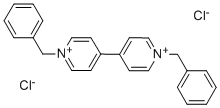1,1'-DIBENZYL-4,4'-BIPYRIDINIUM DICHLORIDE
Synonym(s):1,1′-Dibenzyl-4,4′-bipyridinium dichloride
- CAS NO.:1102-19-8
- Empirical Formula: C24H22Cl2N2
- Molecular Weight: 409.35
- MDL number: MFCD00011991
- EINECS: 214-158-5
- SAFETY DATA SHEET (SDS)
- Update Date: 2024-07-14 20:44:35

What is 1,1'-DIBENZYL-4,4'-BIPYRIDINIUM DICHLORIDE?
The Uses of 1,1'-DIBENZYL-4,4'-BIPYRIDINIUM DICHLORIDE
BVD can be reduced to its neutral state by using sodium borohydride, which forms an n-type dopant for organic semiconductor based applications. It may be introduced to form a path for the transport of electrons from the thylakoid membranes to the mediator, which can be used in the fabrication of photo-driven bioanode. It also acts as a dopant with 2D layered materials to form an n-type chemical dopant that can be used to enhance the electrical properties of the triboelectric devices.
General Description
Benzyl viologen dichloride (BVD) is an electrochromic indicator, which contains two chlorine atoms and an organic constituent attached with two nitrogen cations. In a redox reaction, BVD can be reduced in three states with different colors.
Properties of 1,1'-DIBENZYL-4,4'-BIPYRIDINIUM DICHLORIDE
| Melting point: | 262 °C (dec.) |
| storage temp. | Sealed in dry,Room Temperature |
| Water Solubility | Soluble in water |
| form | Solid |
| color | White to off-white |
| BRN | 3811585 |
| CAS DataBase Reference | 1102-19-8(CAS DataBase Reference) |
Safety information for 1,1'-DIBENZYL-4,4'-BIPYRIDINIUM DICHLORIDE
| Signal word | Warning |
| Pictogram(s) |
 Exclamation Mark Irritant GHS07 |
| GHS Hazard Statements |
H302:Acute toxicity,oral H312:Acute toxicity,dermal H315:Skin corrosion/irritation H319:Serious eye damage/eye irritation H332:Acute toxicity,inhalation H335:Specific target organ toxicity, single exposure;Respiratory tract irritation |
| Precautionary Statement Codes |
P261:Avoid breathing dust/fume/gas/mist/vapours/spray. P264:Wash hands thoroughly after handling. P264:Wash skin thouroughly after handling. P270:Do not eat, drink or smoke when using this product. P271:Use only outdoors or in a well-ventilated area. P280:Wear protective gloves/protective clothing/eye protection/face protection. P321:Specific treatment (see … on this label). P304+P340:IF INHALED: Remove victim to fresh air and Keep at rest in a position comfortable for breathing. P305+P351+P338:IF IN EYES: Rinse cautiously with water for several minutes. Remove contact lenses, if present and easy to do. Continuerinsing. P501:Dispose of contents/container to..… |
Computed Descriptors for 1,1'-DIBENZYL-4,4'-BIPYRIDINIUM DICHLORIDE
| InChIKey | NLOIIDFMYPFJKP-UHFFFAOYSA-L |
New Products
Tert-butyl bis(2-chloroethyl)carbamate (S)-3-Aminobutanenitrile hydrochloride N-Boc-D-alaninol N-BOC-D/L-ALANINOL 3-Morpholino-1-(4-nitrophenyl)-5,6-dihydropyridin- 2(1H)-one Furan-2,5-Dicarboxylic Acid Tropic acid N-octanoyl benzotriazole 1,1’-CARBONYLDIIMIDAZOLE R-2-BENZYLOXY PROPIONIC ACID 4-HYDROXY BENZYL ALCOHOL 1,1’-CARBONYLDI (1,2-4 TRIAZOLE) S-2-CHLORO PROPIONIC ACID (2-Hydroxyphenyl)acetonitrile 4-Bromopyrazole 5-BROMO-2CYANO PYRIDINE 5-broMo-2-chloro-N-cyclopentylpyriMidin-4-aMine 2-(Cyanocyclohexyl)acetic acid 4-methoxy-3,5-dinitropyridine 2-aminopropyl benzoate hydrochloride 1-(4-(aminomethyl)benzyl)urea hydrochloride diethyl 2-(2-((tertbutoxycarbonyl)amino) ethyl)malonate tert-butyl 4- (ureidomethyl)benzylcarbamate Ethyl-2-chloro((4-methoxyphenyl)hydrazono)acetateRelated products of tetrahydrofuran








You may like
-
 1,1'-Dibenzyl-4,4'-bipyridinium Dichloride CAS 1102-19-8View Details
1,1'-Dibenzyl-4,4'-bipyridinium Dichloride CAS 1102-19-8View Details
1102-19-8 -
 Benzyl viologen dichloride CAS 1102-19-8View Details
Benzyl viologen dichloride CAS 1102-19-8View Details
1102-19-8 -
 55441-95-7 99%View Details
55441-95-7 99%View Details
55441-95-7 -
 N-Vinylformamide 99%View Details
N-Vinylformamide 99%View Details
13162-05-5 -
 Chloro Uracil 1820-81-1 99%View Details
Chloro Uracil 1820-81-1 99%View Details
1820-81-1 -
 2-ethyl-6-methyl-3-hydroxypyridine succinate 99%View Details
2-ethyl-6-methyl-3-hydroxypyridine succinate 99%View Details
127464-43-1 -
 2-ETHYLPYRIDINE 100-71-0 99%View Details
2-ETHYLPYRIDINE 100-71-0 99%View Details
100-71-0 -
 181228-33-1 (S)-Methyl 3-amino-2-((tert-butoxycarbonyl)amino)propanote Hydrochloride (DAP-OMe. HCl) 99%View Details
181228-33-1 (S)-Methyl 3-amino-2-((tert-butoxycarbonyl)amino)propanote Hydrochloride (DAP-OMe. HCl) 99%View Details
181228-33-1